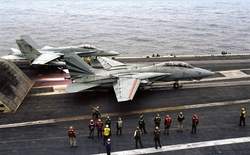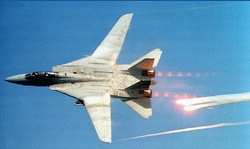 As supersonic engines roar to life and iron wings
spread to their full extension, a great predator of the sky nears
extinction. As it soars 50,000 feet above, nearing a speed of Mach
2, the F-14 Tomcat approaches its retirement from active duty with
style, grace and ferocity.
As supersonic engines roar to life and iron wings
spread to their full extension, a great predator of the sky nears
extinction. As it soars 50,000 feet above, nearing a speed of Mach
2, the F-14 Tomcat approaches its retirement from active duty with
style, grace and ferocity.
Originally designed in the early '70s to attack and destroy
enemy aircraft, the Tomcat has reached the end of its service life,
explained Cmdr. Doug Waters, executive officer of Carrier Air Wing
(CVW) 5’s Fighter Squadron (VF) 154, embarked on USS Kitty
Hawk (CV 63), one of 10 F-14 squadrons in the Navy. “The
F-14’s been around for a long time. It’s been a great
fighter and a strike fighter. It’s just getting old,”
said Waters.
Although the Tomcat has been upgraded and modified since its
debut to the world, the 30-year-old design requires too much
maintenance, explained Waters. Because of older hydraulic and
electrical systems, the F-14 is more difficult to maintain than
newer aircraft.

“Our squadron flies F-14As, which is the original model
Tomcat,” said Waters. “It’s a testimony to how
good our maintainers are, that they’re able to keep those
jets full-mission capable and lethal as they are.” According
to Waters, in the '90s, naval leadership made the decision to phase
out the Tomcat and replace it with the F/A-18 E/F Super Hornet. The
F/A-18 E model of the Super Hornet is a single-seat aircraft, while
the F/A-18 F’s two-person crew resembles the F-14’s
crew more closely, with a pilot and a radar intercept officer.
 “What you get with the Super Hornet is a
brand new airplane, with upgraded avionics, with modern ergonomics,
plus the fuel capacity and range and endurance you have in a
Tomcat. All that, with a digital architecture,” said
Waters
“What you get with the Super Hornet is a
brand new airplane, with upgraded avionics, with modern ergonomics,
plus the fuel capacity and range and endurance you have in a
Tomcat. All that, with a digital architecture,” said
Waters
The schedule for replacing the Tomcat with the Super Hornet is
created by the Transition Squadron Process Action Team (TSPAT).
TSPAT looks at the schedules of carriers, squadrons, schools, and
any other organization that will be affected by the transition, in
order to come up with the best schedule to phase out the Tomcat,
Waters said.
“Generally, an air wing will come off of a deployment, and
the squadrons will have to transition then,” explained
Waters. “The Tomcat will eventually be retired completely by
2007. Our transition will probably occur this fall.” During
their scheduled transition time CVW-5’s Tomcat pilots will
join Fleet Replacement Squadron (FRS) VFA-122. FRS are
post-training commands, where pilots learn to fly specific
aircraft. Pilots already trained to fly the Super Hornet will also
be brought into the existing squadrons, to provide their valuable
experience, explained Waters. Tomcat maintenance crews will spend
their transition time in maintenance training school, learning
about the Super Hornet.
 The 10 squadrons that fly Tomcats will remain
squadrons, however, they will be adding an “A” to their
squadron identification. The Black Knights of VF-154 will become
VFA-154, explained Waters. “The Tomcat squadrons that
transition will maintain their lineage, their heritage and their
name,” he said.
The 10 squadrons that fly Tomcats will remain
squadrons, however, they will be adding an “A” to their
squadron identification. The Black Knights of VF-154 will become
VFA-154, explained Waters. “The Tomcat squadrons that
transition will maintain their lineage, their heritage and their
name,” he said.
As for the fate of the Tomcats, that decision will be made by
Commander Fighter Wing Atlantic. After a squadron’s
transition period, the Tomcats will be evaluated. Based on that
evaluation, they will either be sent back to the fleet until the
full phasing out period is completed, or the Tomcats will be
preserved in a desert environment. By preserving the Tomcats, the
Navy will be able to pull them out of retirement should the need
ever be required, explained Waters.
“I have mixed emotions. I’ve flown the Tomcat my
entire career. I have over 2,500 hours in it,” said Waters.
“It’s a great airplane. I love flying it. You get an
emotional attachment to aircraft that you fly, especially that
much. But I realize the future of naval aviation lies in the Super
Hornet. It’s time for the Tomcat to move on.”

America's oldest active warship, Kitty Hawk with embarked CVW-5
currently operates with coalition forces in support of Operation
Iraqi Freedom, the multinational coalition effort to liberate the
Iraqi people, eliminate Iraq's weapons of mass destruction and end
the regime of Saddam Hussein. [ANN Thanks Journalist Seaman David
Beyea, USS Kitty Hawk Public Affairs]
 ANN's Daily Aero-Linx (04.15.24)
ANN's Daily Aero-Linx (04.15.24) Classic Aero-TV: 'No Other Options' -- The Israeli Air Force's Danny Shapira
Classic Aero-TV: 'No Other Options' -- The Israeli Air Force's Danny Shapira Aero-News: Quote of the Day (04.15.24)
Aero-News: Quote of the Day (04.15.24) Airborne 04.16.24: RV Update, Affordable Flying Expo, Diamond Lil
Airborne 04.16.24: RV Update, Affordable Flying Expo, Diamond Lil ANN's Daily Aero-Term (04.16.24): Chart Supplement US
ANN's Daily Aero-Term (04.16.24): Chart Supplement US







